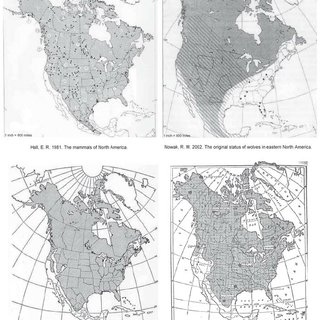NOTES 227
DISCUSSION
Correspondence of range maps in the southeastern states was lacking, probably
due to unresolved species relationships among the gray wolf, coyote, Canis latrans, and red wolf, Canis rufus (Nowak 2002). Most discrepancies among historical gray wolf range maps occurred in the western states, especially in California. Range maps used in our analysis indicate gray wolves rarely occupied the central, coastal, or southern portions of the state. Young and Goldman (1944) postulated that wolves were rarely found in deserts; but some of their results indicated that gray wolves did inhabit those regions. Early records document wolves in the Sacramento Valley, and near the San Joaquin River in Madera County (Young and Goldman 1944). In 1918, a wolf was killed
in Los Angeles County and in 1922 a gray wolf was trapped in the Providence
Mountains, San Bernardino County (Young and Goldman 1944:58, Hall 1981). Young and Goldman (1944) and Hall (1981) report wolves probably inhabited areas near Mono Lake and Mount Dana in Mono County in 1930.
Information for many historical range maps came from diaries of trappers, settlers, and explorers. Some range boundaries may be questionable because they were based on historical records or erroneous descriptions of specimen locations. Revisiting original records of gray wolf distribution may help to produce more meaningful and, perhaps, accurate range maps but many descriptions are cursory or may reflect inaccurate location data. Schmidt (1991:84) suggested that further research of artifacts, historical documents, and other “paleontological searches” be conducted to enhance
data already available. Differences among historical range maps of the gray wolf
suggests more effort is needed to identify historical animal ranges in the western United States, particularly in California, the only state where apparently, large areas were never occupied by wolves.
Failure to confirm animal sightings or obtain additional sources of evidence to
corroborate historical presence of wildlife may lead to inconsistencies in historical range maps. Our analysis of historical range maps of the gray wolf illustrates this. It is likely that historical range maps of other charismatic, large mammal species are also inconsistent.
LITERATURE CITED
Hall, E. R. 1981. The mammals of North America. John Wiley & Sons, New York, USA.
Leopold, A. S., R. J. Gutierrez, and M. T. Bronson. 1981. North American game birds and
mammals. Charles Scribner’s Sons, New York, USA.
Nowak, R. M. 2002. The original status of wolves in eastern North America. Southeastern
Naturalist 1:95-130.
Schmidt, R. H. 1991. Gray wolves in California: their presence and absence. California Fish and
Game 77:79-85.
Seton, E. T. 1953. Lives of game animals. Charles T. Branford Co., Boston, USA.
Young, S. P. and E. A. Goldman. 1944. The wolves of North America: Part I – their
history, life habits, economic status, and control. The American Wildlife Institute,
Washington D. C., USA.
Received: 27 August 2006
Accepted: 24 February 2007
